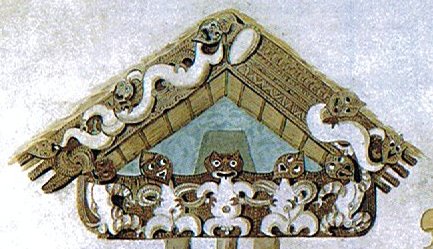In P the hahe glyph conforms to my glyph type variant:
The impression of a conjunction (in Qb2-9) is - it seems - instead delivered by the preceding niu (Pa11-20). The cross at the top of niu glyphs can easily be imagined as the origin from which the hahe glyph type has evolved. Counting glyphs and then dividing by 3, followed by adding 64, is a model which possibly is applicable in P:
260 could then be referring to the end of summer according to a calendar with 13 times 20 days. However, we have learned that one should not stop searching when finding the first interesting result. More than one reading seems to be the norm of rongorongo. 11 * 21 (as in Pa11-21) is a strong sign, because 11 * 21 = 231 (equal to for instance the ordinal number of the first glyph on side b of G):
231 + 64 = 295 is therefore a more plausible day value for hahe in Pa11-21. We surely must try to put each day as 2 glyphs. However, we then will find the day number at hahe to be 294 (without having added 64 days):
A break in time is clearly between Pa11-22 and Pa11-23 - the hands have vanished at the end of day 294. And 588 can be read as 58 times 8, which is equal to 16 * 29. There is no more light and an allusion to day 290 can be imagined. In Pa11-23 henua (the land) lies in darkness. The fat honu in the first half of day 290 is followed by a smaller one in the afternoon. Mea ke lies in front (Pa11-15) and it is another kind of light. Niu in Pa11-20 has as its bottom element a puo sign, presumably suggesting 'hilled up' (no longer visible). The double niu glyph in the first half of day 292 (100 more than 192) seems to illustrate how they are producing a little egg between them, and we should remember the apex of the Taranaki storehouse:
|
|||||||||||||||||||||||||||||||||||||||||||||||||||||||||||||||||||||||||||||||||||||||||||||||||||||||||||||||||||||||||||
























